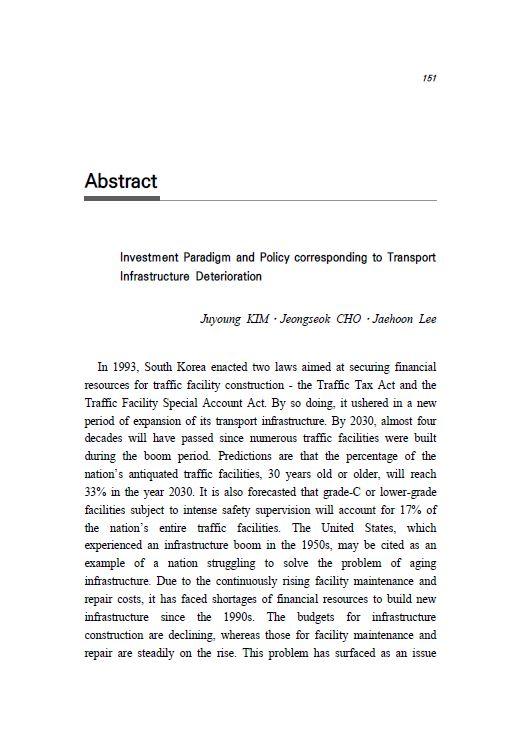General Research

RESEARCH
KOTI - Korea Transport institute
Investment Paradigm and Policy corresponding to Transport Infrastructure Deterioration
- Date
December 31 2015
- Page(s)
page(s)
#Traffic SOC
#traffic SOC aging
#traffic SOC status
#traffic SOC safety diagnosis level
#SOC maintena

In 1993, South Korea enacted two laws aimed at securing financial resources for traffic facility construction - the Traffic Tax Act and the Traffic Facility Special Account Act. By so doing, it ushered in a new period of expansion of its transport infrastructure. By 2030, almost four decades will have passed since numerous traffic facilities were built during the boom period. Predictions are that the percentage of the nation’s antiquated traffic facilities, 30 years old or older, will reach 33% in the year 2030. It is also forecasted that grade-C or lower-grade facilities subject to intense safety supervision will account for 17% of the nation’s entire traffic facilities. The United States, which experienced an infrastructure boom in the 1950s, may be cited as an example of a nation struggling to solve the problem of aging infrastructure. Due to the continuously rising facility maintenance and repair costs, it has faced shortages of financial resources to build new infrastructure since the 1990s. The budgets for infrastructure construction are declining, whereas those for facility maintenance and repair are steadily on the rise. This problem has surfaced as an issue of contention in the American society. In Korea, the problem of aging traffic facilities has not yet reached a critical stage. However, the costs needed to maintain and repair the roadways, railways and harbors are predicted to rise to about 10 trillion won in 2030. This will likely cause numerous social conflicts. The government has announced a fiscal policy to slash its transport infrastructure budget by an annual average of 6.2% over the next five years, citing various reasons, including budget increases in the welfare sector. On the other hand, there will likely be continuing demand for new infrastructure construction for some time to come, amid steady increases in the maintenance and repair budget for the aging traffic facilities. Given these conditions, the problem of investment fund shortages is likely to come to the fore in the transport sector. Budget increases related to maintenance and repair works will curb new construction demand. Furthermore, the debt and current account deficit problems are expected to get worse at both the state and local government levels, because of growth in their spending on facility maintenance and repair projects. The rising maintenance expenses will likely affect not just the state-controlled facilities like the national highways, general and high-speed railways, and harbors. They will also have impacts on the provincial roads managed by local governments, the expressways under the control of Korea Expressway Corporation, and urban railways. In 2030, the maintenance and repair costs for the provincial roads will make up an estimated 19.8%, as a percentage of the local governments’ entire transportation budgets for 2016. The expenses for the expressways and urban railways are predicted to account for 24.8% and 58.3%, respectively, as percentages of the total expected revenues of Korea Expressway Corporation and urban railway corporations. On the other hand, various environment-related factors, such as eco-friendly transport policies designed to cope with climate change and advances in automobile technologies (increase in fuel efficiency), will likely cause reductions in the national and provincial tax revenues. Besides, the expressway toll and urban railway fare revenues are expected to decline because of the anticipated advent of a hyper-aged society in Korea and increase in the use of light cars, unless there are changes in the current pricing policies. The rising costs for the maintenance and repair of the aging traffic facilities are likely to cause conflicts in the following areas: priority adjustment between new infrastructure projects and the existing repair and maintenance works; tax revenue allocation and budget adjustment between the state and local governments; and, the shouldering of debt and current account deficit burdens by the traffic facility operation agencies. This makes it necessary to secure transport investment funds and map out mid- and long-term policies designed to resolve conflicts. Additionally, efforts should be exerted to prevent safety accidents caused by antiquated facilities and reduce the maintenance and repair costs. An institutional framework for mid-term maintenance and repair plans ought to be established so that the aging facilities could be managed in a systematic manner. There is also a need to continuously expand the asset management system in an effort to ensure preventive maintenance and repair of the aging facilities and pursue relevant budget cuts. This study makes transport policy proposals after analyzing social disputes that might be brought about by the aging transport infrastructure.